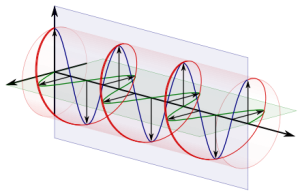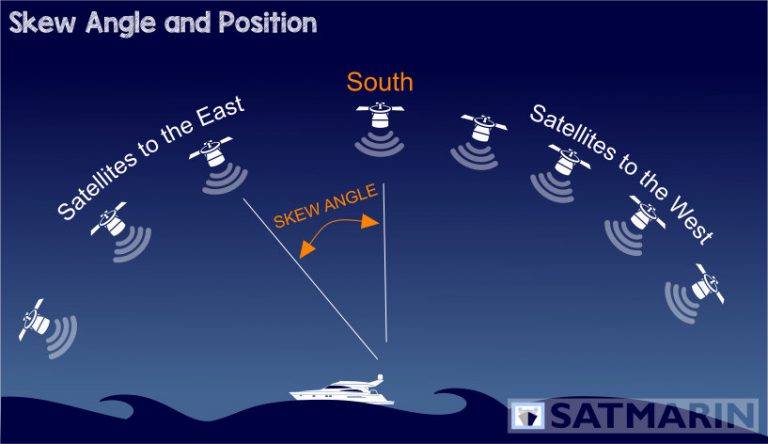
Maritime Satellite TV
To receive Satellite TV at Sea you will need a Maritime Stabilized Satellite TV Antenna. This antenna will point to the satellite regardless of the movements of the ship it is on and will do this very accurately. Keep in mind that the satellite is at approximately 35.000 km distance. So you could compare it to shooting through a keyhole with a laserpointer while sitting on a mechanical bull. Not easy if you have to do this manually.
Electromarinaservice can recommend a wide range of antennas depending on your requirements. Our portfolio includes the full range of Seatel/Cobham/Sailor, Intellian and KNS antennas in Ku, Ka, and C-Band.
Antenna Size
Usually the size of the antenna is determined by the size of the ship it will be installed on. Larger ships will have larger antennas and smaller ships smaller. This is mostly due to space and budget but can have aesthetic reasons as well.
Larger antennas receive more signal and will allow you to watch TV in more remote areas or in worse weather conditions than the smaller versions. You should therefore always try to get the largest possible antenna on your ship.
Circular or Linear Polarization

Satellite TV signals are transmitted orthogonally, which means that from the satellite signals are sent horizontally and vertically. This is usually the case in EMEA and Asia. They can also be circular, which means the signal rotates with or counter clockwise. This is more common in the US.
When selecting an antenna for reception of orthogonal signals (horizontal or vertically polarized) then the angle of the of the satellite receiver will become very important. If the skew angle is incorrectly set, which depends your position and the selected satellite, your TV signal will be poor. A 10° error can already make the difference between a good image and no image. More about this when talking about the choice of 2 or 3 axis antennas.
First of all the polarity is important to choose the right LNB (Low Noise Block Down Converter – the receiver). Depending on the region you will sail in you will select either Orthogonal or Circular polarization. For larger vessels who frequenctly need to switch from Circular polarization to Orthogonal you should consider an antenna with the ability to switch between both (Intellian t110W and t130W)
2-Axis or 3-Axis antennas
2-Axis antennas are for ships that don’t move heavily (rivers, lakes, in harbour, calm sea, …). The antenna will move around its azimuth (yaw) and elevation (pitch) axis and will usually have a manual or automatic skew adjustment.
So why would you need a 3 axis antenna.
 Skew Adjustment: In a 2-axis antenna your skew angle will not move along with the roll or pitch of your ship. If this becomes big (remember the 10° angle when we talked about Orthogonal polarization) then your receiver will not be well aligned with the satellite signal and you will have permanent or intermittent less than optimal signal reception.
Skew Adjustment: In a 2-axis antenna your skew angle will not move along with the roll or pitch of your ship. If this becomes big (remember the 10° angle when we talked about Orthogonal polarization) then your receiver will not be well aligned with the satellite signal and you will have permanent or intermittent less than optimal signal reception.
If you are going to watch TV at sea during heavy sea then it is recommended to choose a 3-axis antenna which will be able to receive a stronger signal than its same size 2-axis counterpart because of the use of the 3rd cross (roll) axis.
Skew adjustment = ability to adjust the receiver to your geographic location so that the receiver is set parallel to the signal. This only changes when your location changes (by more than tens of kilometers)
Beware: Some manufacturers will advertise 2-axis antennas with automatic skew as a 3-axis antennas. This is not the same as ‘real’ 3-axis antennas which should then be called 4-Axis (yaw, pitch, roll AND skew)
Maritime Satellite TV
 In order to receive Maritime Satellite TV you will need a Maritime Stabilized Satellite TV Antenna. This antenna will point to the satellite regardless of the movements of the ship it is on and will do this very accurately. Keep in mind that the satellite is at approximately 35.000 km distance. You could compare it to shooting through a keyhole with a laserpointer while sitting on a mechanical bull. Not easy if you have to do this manually.
In order to receive Maritime Satellite TV you will need a Maritime Stabilized Satellite TV Antenna. This antenna will point to the satellite regardless of the movements of the ship it is on and will do this very accurately. Keep in mind that the satellite is at approximately 35.000 km distance. You could compare it to shooting through a keyhole with a laserpointer while sitting on a mechanical bull. Not easy if you have to do this manually.
While pointing an antenna at a satellite so far away there are several other aspects you will need to keep in mind:
Coverage of the satellite beam
Satellite TV channels are regional by default and will usually only be available on one or just a few satellites. Because of this limited coverage it is important to check whether you will be able to receive the channels you have subscribed for in the areas you will be sailing to.
Most popular satellite TV packages are Sky UK and Sky Italia because they contain a lot of english speaking channels. Their coverage is however limited and you need to check carefully if you will be able to receive the specific channels, especially for Sky UK which has moved a lot of channels to only be received in UK.
Satellite Package selection
There are many satellite TV packages available beyond the two mentioned above. See our list of for more details on which package is available on which satellite.
| Package | Satellite |
| A1 | Eutelsat 16A |
| Alma TV | KazSat 3 |
| American Forces Network | Eutelsat 9B |
| Antik Sat | Eutelsat 16A |
| Azam TV | Eutelsat 7B |
| BeIn | Badr 5 & Eutelsat 25B/Es’hail 1 |
| Bis TV | Eutelsat Hot Bird 13C |
| Bobbles | Astra 1KR/1N |
| Bulsatcom | Hellas Sat 2/3 |
| Canal Digitaal | Astra 3B & Astra 1L |
| Canal France | Astra 1L/1M/1N |
| Canal Réunion | Eutelsat 16A |
| Caspio HD | KazSat 3 |
| Cosmote TV | Eutelsat 9B |
| Cyfrowy Polsat | Eutelsat Hot Bird 13B/13C |
| Dialog TV | Intelsat 904 |
| DigitAlb | Eutelsat 16A |
| Digiturk | Türksat 3A/4A & Eutelsat 7A |
| DishHome | Amos 4 |
| D-Smart | Türksat 3A/4A |
| DSTV Africa | Eutelsat 36B & Express AMU1 |
| DSTV South Africa | Intelsat 20 |
| Filbox | Türksat 4A |
| Freesat | Eutelsat 16A |
| HD Austria | Astra 1N |
| HD+ | Astra 1KR/1L/1N |
| Jain Hits | Intelsat 902 |
| Joyne | Eutelsat 9B |
| Kwesé | Eutelsat 7B |
| M7 Deutschland | Eutelsat 9B |
| MagtiSat | Astra 5B |
| Max TV | Eutelsat 16A |
| Movistar+ | Astra 1KR/1L/1M |
| My HD | Badr 5/6 |
| My TV Smart | Eutelsat 16A |
| NC+ | Eutelsat Hot Bird 13C |
| Nova | Eutelsat Hot Bird 13B |
| NTV Plus | Eutelsat 36B & Express AMU1 |
| NTV Plus Vostok | Express AT1 |
| Openview HD | Intelsat 20 |
| Orange France | Astra 1N |
| Orange Polska | Eutelsat Hot Bird 13C |
| Orange Réunion | Eutelsat 16A |
| Orange România | Astra 5B |
| ORF Digital | Astra 1KR/1L/1N |
| Otau TV | KazSat 3 |
| Pantelio | Belintersat 1 |
| Parabole Réunion | Eutelsat 16A |
| Play | Astra 2F |
| Satelio | Astra 4A |
| Sky Deutschland | Astra 1KR/1L/1M/1N |
| Sky Italia | Eutelsat Hot Bird 13B/13C |
| Sky UK | Astra 2E/2F/2G |
| Skylink | Astra 3B |
| SRG SSR | Eutelsat Hot Bird 13B/13C |
| StarSat | SES 5 |
| StarTimes TV | Eutelsat 10A |
| Telekom TV | Hellas Sat 2/3 |
| Tivibu | Türksat 4A |
| Total TV | Eutelsat 16A |
| Total TV Bosna & Hercegovina | Eutelsat 16A |
| Total TV Crna Gora | Eutelsat 16A |
| Total TV Hrvatska | Eutelsat 16A |
| Total TV Makedonija | Eutelsat 16A |
| Total TV Slovenija | Eutelsat 16A |
| Total TV Srbija | Eutelsat 16A |
| Tricolor TV | Eutelsat 36B & Express AMU1 |
| Tricolor TV Sibir | Express AT1 |
| Tring Digital | Eutelsat 16A |
| TV Sat Africa | Eutelsat 16A |
| TV Vlaanderen | Astra 3B & Astra 1L |
| Viasat | Astra 4A & SES 5 |
| Viasat Danmark | Astra 4A & SES 5 |
| Viasat Eesti | Astra 4A & SES 5 |
| Viasat Latvija | Astra 4A & SES 5 |
| Viasat Lietuva | Astra 4A & SES 5 |
| Viasat Norge | Astra 4A & SES 5 |
| Viasat Suomi | Astra 4A & SES 5 |
| Viasat Sverige | Astra 4A & SES 5 |
| Viasat Ukraina | Astra 4A |
| Vip Sat TV | Eutelsat 16A |
| Vivacom TV | Intelsat 904 |
| Xtra TV | Eutelsat 9B |
| Zap | Eutelsat 36B |
| ZeonBud | Astra 4A |
| Zuku | SES 5 |
Antenna Size
If you are sailing in the middle of the footprint of a satellite you might not need a very large satellite TV antenna to receive HD channels. The smallest recommended size for receiving HD signals is 60cm and should work in most cases. If you are uncertain about whether your location has enough on a 60cm you can always check the satellite footprints on http://www.satbeams.com where you can select the required satellite and beam and if you then click on your location it will give you the recommended antenna size, providing that you are in the coverage of the footprint.
Sometimes you will however need a larger antenna to receive satellite signals when there is heavy rain, when you are on the edge of the footprint or when the satellite signal is not so strong. To have an idea on the recommended antenna size you can start at http://www.satbeams.com.
Polarization
It is important to know that thee are two types of polarization, this is the way that the signals are transmitted. One is Linear, which is used is most parts of the world for Ku Band TV and the other one is Circular which is mostly used in the Americas.
If ou are going to travel in both areas it is recommended to either have replacement LNB’s (Low Noise Block down converter) or easier, you can get a maritime stabilized antenna which has both linear and circular LNBs installed
2 or 3 Axis Antennas
Although we do no longer offer two axis TVRO antennas due to the fact that they do not perform as well as their 3-axis counterpart it is important to know which type of maritime TV satellite antenna you have. A 2-axis model will only change its azimuth and its elevation. To receive an optimal signal (on linear polarization) you will also need to adjust the LNB so that it aligns perfectly with the satellite transmission plane. On a 2-axis antenna the skew angle will be adjusted but it will not adjust itself to the additional ship motion, which is done automatically on a 3 axis.


